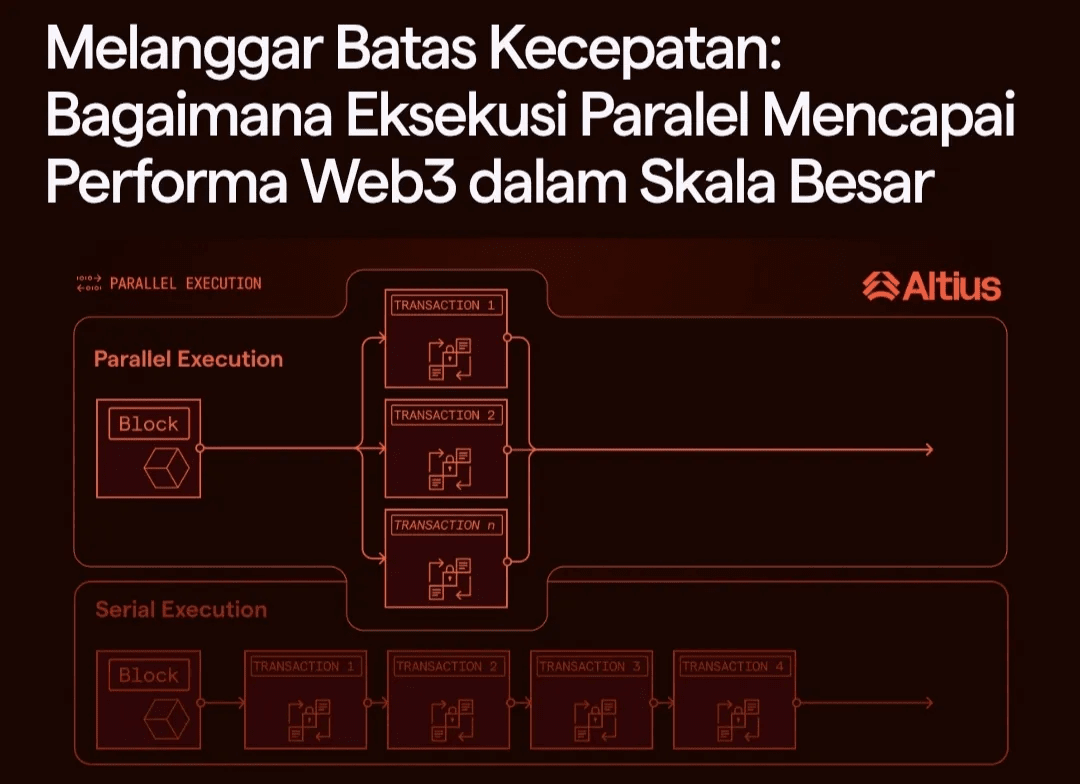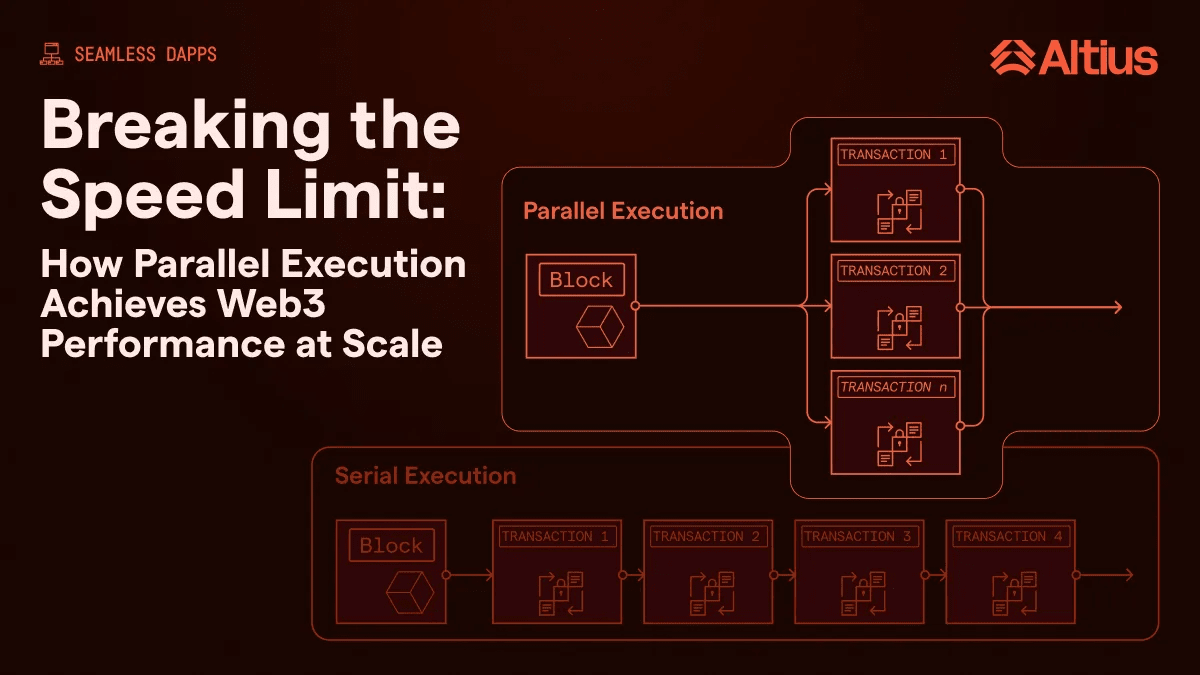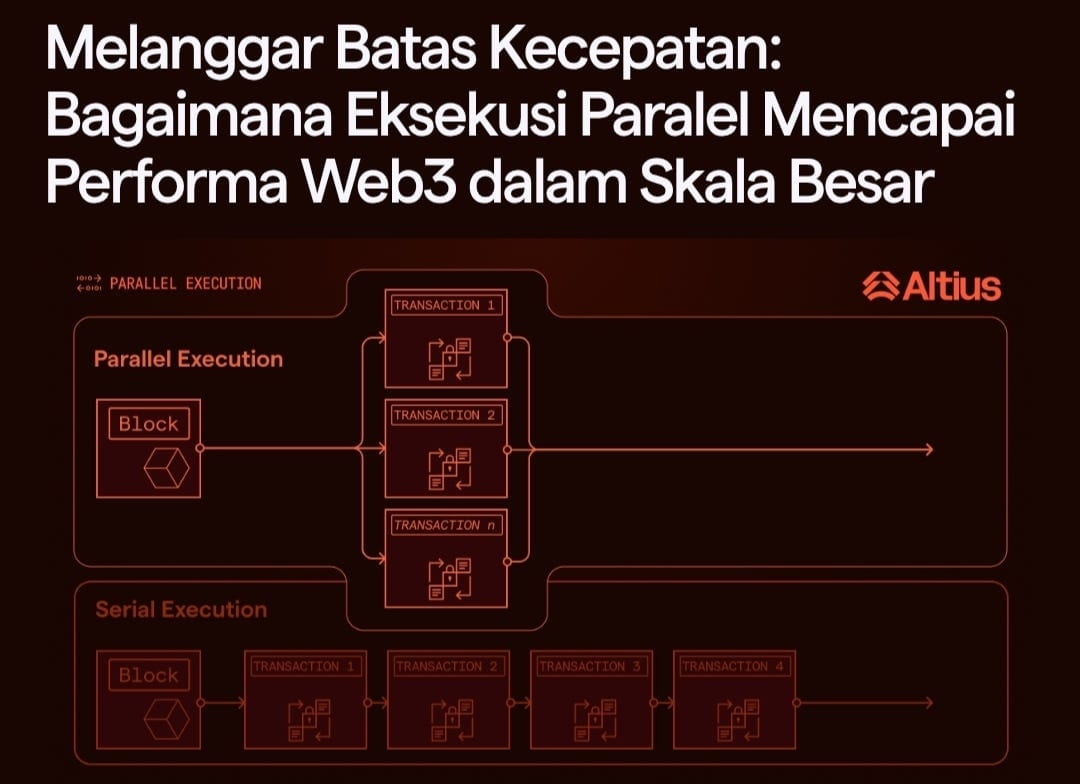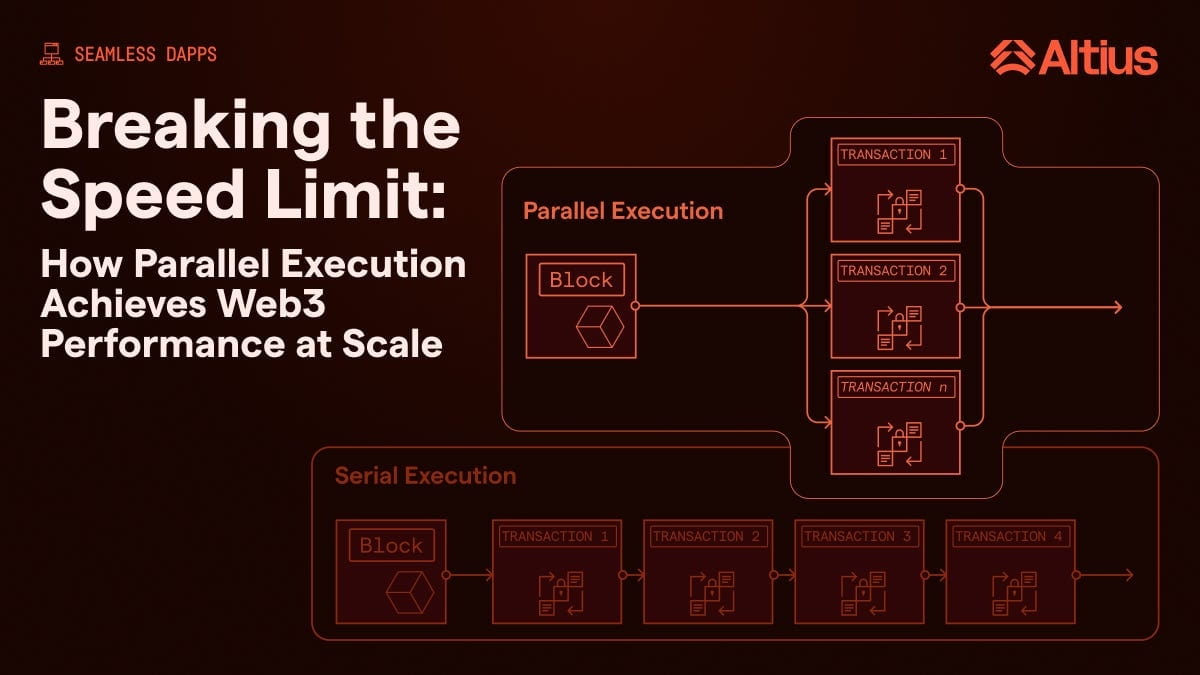
In short;
Traditional blockchains process transactions sequentially, creating bottlenecks on performance.
Altius uses parallel execution to process multiple transactions simultaneously, unlocking gigabyte-per-second throughput.
Supported by Static Single Assignment (SSA) and optimistic concurrency control, we ensure correctness while moving fast.
Benchmark tests show record-breaking throughput, both in TPS and gas per second.
Altius offers a modular execution layer that any chain can integrate to improve performance without compromising EVM compatibility or security.

Why Blockchain Throughput Has Hit a Wall
Understanding blockchain performance constraints requires examining the fundamental trade-offs faced by early blockchain designers. When Satoshi Nakamoto created Bitcoin, his main concern was not transaction throughput — rather, it was solving the double-spending problem in a decentralized environment. The solution involved sequential processing: transactions are validated and executed one by one, in strict order.
This sequential approach solves crucial problems surrounding consensus and state consistency, but elegance comes at a cost. Sequential processing creates inherent bottlenecks where transaction throughput is fundamentally limited by the time it takes to execute the slowest transaction in a block.
The introduction of Ethereum smart contracts reinforces these barriers. Unlike simple Bitcoin payments, Ethereum transactions can trigger complex computational operations. The EVM exacerbates these limitations through a single-threaded architecture, meaning even advanced validator hardware cannot leverage multiple CPU cores for transaction processing.
Layer 2 solutions have provided temporary relief, but they inherit the same sequential processing limitations. The fundamental bottleneck remains — only pushed up the stack.
Altius's Approach to Parallel Execution
The parallel execution architecture of Altius Labs is a fundamental reimagining of blockchain transaction processing. Instead of imposing parallelization on existing sequential systems, Altius builds a foundational solution that treats parallel execution as a first-class design principle while maintaining full EVM compatibility.
Modular Execution Meets Advanced Compiler Theory
At the core of Altius's approach is a form of Static Single Assignment (SSA) combined with optimistic concurrency control. When transactions arrive, the system immediately analyzes its SSA representation to identify state dependencies, creating a clear dependency graph that shows which transactions can be safely executed in parallel.
This analysis occurs at the bytecode level, meaning it works seamlessly with existing Solidity smart contracts without requiring modifications. Developers continue to write contracts exactly as they would for Ethereum's mainnet.
Optimistic concurrency control complements SSA analysis by enabling speculative execution. Instead of waiting for all potential conflicts to resolve, Altius assumes most transactions will not experience conflicts and starts processing them immediately on multiple cores.
How It Differs from Traditional EVM Execution
Traditional EVM execution follows a strict linear model, where each transaction waits for the previous transaction to complete. Altius creates multiple parallel execution contexts, each capable of processing EVM bytecode identically to Ethereum's mainnet, while maintaining a coordination layer that manages dependencies and ensures correctness.
Key benefits:
Scale throughput with available hardware
Simple transactions are not hindered by complex operations
Perfect compatibility with existing Ethereum tooling
Economics of Parallel Execution
Cost Reduction Through Efficiency
Traditional blockchain networks face a direct relationship between demand and transaction costs. Parallel execution breaks this scarcity model by drastically increasing the supply of computational resources available for transaction processing.
When blockchains can process 10x or 100x more transactions per block, the economic pressure driving gas price increases is significantly reduced. Users benefit from lower transaction fees, while applications can economically support use cases that were previously too costly.
This increase in efficiency creates a positive feedback loop: lower transaction costs drive more usage, generating more fees for validators, which supports network security, attracting more developers and users.
Network Effects and Ecosystem Growth
High-performance blockchain infrastructure creates network effects that accelerate ecosystem growth beyond linear performance improvements. Along with reduced costs and increased yields, new application categories become viable, attracting developers who were previously excluded due to performance limitations.
Parallel execution allows blockchain networks to effectively compete with traditional infrastructure for enterprise use cases that require performance guarantees and cost predictability.
Technical Dive: Implementation Details
Transaction Dependency Analysis
Altius uses advanced static analysis techniques that examine transaction bytecode to extract dependency information before execution begins. The system operates on multiple levels of abstraction:
Contract level: Simple parallelization when transactions touch different contracts
Function level: Analyzing calls, events, and external interactions
Storage level: Tracking individual slot read/writes for maximum parallelization
Machine learning techniques enhance dependency analysis by learning from historical patterns to predict conflicts and optimization opportunities.
Search
Write


Emperor
5 min read
·
Jun 8, 2025

In short;
Traditional blockchains process transactions sequentially, creating bottlenecks on performance.
Altius uses parallel execution to process multiple transactions simultaneously, unlocking gigabyte-per-second throughput.
Supported by Static Single Assignment (SSA) and optimistic concurrency control, we ensure correctness while moving fast.
Benchmark tests show record-breaking throughput, both in TPS and gas per second.
Altius offers a modular execution layer that any chain can integrate to improve performance without compromising EVM compatibility or security.

Why Blockchain Throughput Has Hit a Wall
Understanding blockchain performance constraints requires examining the fundamental trade-offs faced by early blockchain designers. When Satoshi Nakamoto created Bitcoin, his main concern was not transaction throughput — rather, it was solving the double-spending problem in a decentralized environment. The solution involved sequential processing: transactions are validated and executed one by one, in strict order.
This sequential approach solves crucial problems surrounding consensus and state consistency, but elegance comes at a cost. Sequential processing creates inherent bottlenecks where transaction throughput is fundamentally limited by the time it takes to execute the slowest transaction in a block.
The introduction of Ethereum smart contracts reinforces these barriers. Unlike simple Bitcoin payments, Ethereum transactions can trigger complex computational operations. The EVM exacerbates these limitations through a single-threaded architecture, meaning even advanced validator hardware cannot leverage multiple CPU cores for transaction processing.
Layer 2 solutions have provided temporary relief, but they inherit the same sequential processing limitations. The fundamental bottleneck remains — only pushed up the stack.
Altius's Approach to Parallel Execution
The parallel execution architecture of Altius Labs is a fundamental reimagining of blockchain transaction processing. Instead of imposing parallelization on existing sequential systems, Altius builds a foundational solution that treats parallel execution as a first-class design principle while maintaining full EVM compatibility.
Modular Execution Meets Advanced Compiler Theory
At the core of Altius's approach is a form of Static Single Assignment (SSA) combined with optimistic concurrency control. When transactions arrive, the system immediately analyzes its SSA representation to identify state dependencies, creating a clear dependency graph that shows which transactions can be safely executed in parallel.
This analysis occurs at the bytecode level, meaning it works seamlessly with existing Solidity smart contracts without requiring modifications. Developers continue to write contracts exactly as they would for Ethereum's mainnet.
Optimistic concurrency control complements SSA analysis by enabling speculative execution. Instead of waiting for all potential conflicts to resolve, Altius assumes most transactions will not experience conflicts and starts processing them immediately on multiple cores.
How It Differs from Traditional EVM Execution
Traditional EVM execution follows a strict linear model, where each transaction waits for the previous transaction to complete. Altius creates multiple parallel execution contexts, each capable of processing EVM bytecode identically to Ethereum's mainnet, while maintaining a coordination layer that manages dependencies and ensures correctness.
Key benefits:
Scale throughput with available hardware
Simple transactions are not hindered by complex operations
Perfect compatibility with existing Ethereum tooling
Economics of Parallel Execution
Cost Reduction Through Efficiency
Traditional blockchain networks face a direct relationship between demand and transaction costs. Parallel execution breaks this scarcity model by drastically increasing the supply of computational resources available for transaction processing.
When blockchains can process 10x or 100x more transactions per block, the economic pressure driving gas price increases is significantly reduced. Users benefit from lower transaction fees, while applications can economically support use cases that were previously too costly.
This increase in efficiency creates a positive feedback loop: lower transaction costs drive more usage, generating more fees for validators, which supports network security, attracting more developers and users.
Network Effects and Ecosystem Growth
High-performance blockchain infrastructure creates network effects that accelerate ecosystem growth beyond linear performance improvements. Along with reduced costs and increased yields, new application categories become viable, attracting developers who were previously excluded due to performance limitations.
Parallel execution allows blockchain networks to effectively compete with traditional infrastructure for enterprise use cases that require performance guarantees and cost predictability.
Technical Dive: Implementation Details
Transaction Dependency Analysis
Altius uses advanced static analysis techniques that examine transaction bytecode to extract dependency information before execution begins. The system operates on multiple levels of abstraction:
Contract level: Simple parallelization when transactions touch different contracts
Function level: Analyzing calls, events, and external interactions
Storage level: Tracking individual slot read/writes for maximum parallelization
Machine learning techniques enhance dependency analysis by learning from historical patterns to predict conflicts and optimization opportunities.
State Consistency and Commitment Protocols
Maintaining state consistency requires sophisticated coordination mechanisms. Altius implements a multi-phase commitment protocol specifically designed for blockchain requirements:
Preparation phase: Parallel execution prepares state changes and participates in conflict detection
Validation phase: Ensuring all changes are consistent with blockchain rules
Commit phase: Applying validated changes atomically while maintaining determinism
Optimization minimizes coordination overhead and allows for high-frequency commitments that support high-throughput operations.
Security Considerations in Parallel Execution
Maintaining Deterministic Execution
Deterministic execution is fundamental to blockchain consensus. Altius ensures determinism through mechanisms that coordinate parallel execution and guarantee consistent outcomes regardless of execution time.
The system includes a comprehensive testing framework that validates deterministic behavior across thousands of scenarios, plus formal verification techniques that mathematically prove that deterministic properties are upheld.
Preventing Race Conditions
Altius employs advanced synchronization mechanisms that prevent race conditions while minimizing performance impact, including lock-free algorithms, atomic operations, and custom blockchain coordination protocols.
Strong atomicity guarantees ensure that transactions either complete fully or have no effect on global state — crucial for blockchain applications that rely on consistent state transitions.
Future Implications and Industry Impact
Enabling New Application Categories
High-performance blockchain infrastructure eliminates historical constraints on decentralized applications:
Real-time applications: Playing games with responsive multiplayer experiences, high-frequency financial trading
IoT applications: Processing large volumes of sensor data and device interactions
Enterprise applications: Supply chain, identity verification, and compliance systems with predictable performance
Competitive Dynamics
Blockchain networks implementing parallel execution gain significant competitive advantages in attracting developers, users, and capital. This advantage creates pressure for other networks to adopt similar technologies or face the risk of obsolescence.
Early adopters can build sustainable competitive moats that benefit participants and investors, while market evolution creates opportunities for performance optimization companies to specialize.
Final Thoughts
The future of Web3 depends on scalable, high-performance infrastructure that does not compromise developer experience or user trust.
With Altius Labs, you no longer have to choose between EVM compatibility and high throughput. We have pushed the speed limits — safely — by redesigning execution itself.
Through parallel processing, modular architecture, and compiler-level innovations like SSA and OCC, we have unlocked performance that was once deemed impossible on-chain.
Good Whether you are building a DeFi protocol, zkRollup, or the next social dApp, Altius gives you the ability to scale. Fast.
